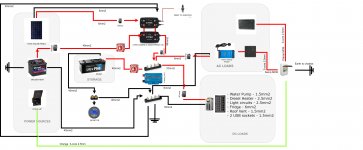JD01
Forum Member
Hi folks,
Hoping to get some eyes over my wiring diagram for my transit minibus conversion. It's a 2015 Transit and i'm about to start running some cables. Electrics are new to me and i've spent a fair while trying to learn over the past few months. I would really appreciate it if someone with more knowledge than me could take a quick look at the diagram.
The plan is to have a 220ah AGM battery under the passenger seat (the starter batteries are under the drivers seat) with the plan to run cables to the rear wheel arch where the electrical cupboard will be.
Any advice would be much appreciated!

Hoping to get some eyes over my wiring diagram for my transit minibus conversion. It's a 2015 Transit and i'm about to start running some cables. Electrics are new to me and i've spent a fair while trying to learn over the past few months. I would really appreciate it if someone with more knowledge than me could take a quick look at the diagram.
The plan is to have a 220ah AGM battery under the passenger seat (the starter batteries are under the drivers seat) with the plan to run cables to the rear wheel arch where the electrical cupboard will be.
Any advice would be much appreciated!


